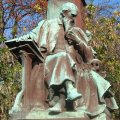
|
|
Set amidst some of
the most spectacular urban scenery in Britain, Kelvin Way Bridge was
designed in 1912, as Radnor Street Bridge, by
Alexander Beith McDonald
, the City
Engineer, and spans the River Kelvin in Kelvingrove Park. It is the only bridge
in the city to feature figurative, bronze sculpture groups as its principal ornament.
The sculpture scheme was the subject of an open competition held in 1914, which was assessed
by
Sir George Frampton
, who had already overseen the selection of the sculpture for the facades
of the nearby Kelvingrove Art Gallery.
|
Philosophy



|
The sculptor selected to produce the groups was the Australian born,
Paul Raphael Montford
, whose London studio had become noted for its production of dynamic
public statues and architectural sculpture. The competition drew twenty eight entries from all over
Britain, its runners-up being Glasgow's
Alexander Proudfoot
and London's Richard Garbe, who each
received a premium of £50 for their work.
|
Industry & Commerce



|
Chosen on the basis that they would make a 'dignified addition to the decoration of the bridge',
the casting of the groups was delayed for twelve years, due to the outbreak of the First World War and
the spiralling cost of bronze. Although the full-scale models were finished by 1918, by which time they had been
exhibited at the RA
, the long awaited casting was completed by the bronze-founder, A B Burton,
of Thames Ditton, and the groups put into position, by June 1926.
|
Inspiration


|
|
Set on sandstone pedestals on the abutments of the bridge, the groups comprise pairs of figures seated
at the base of a pillar supporting four dolphins and a lantern. The groups represent: Philosophy
and Inspiration (north-west corner), Peace and War (north-east), Commerce and Industry (south-west),
and Navigation and Shipbuilding (south-east).
|
Peace & War




|
|
|
Peace



|
Navigation & Shipbuiding



Shipbuilding


|
During the Second World War, the groups were badly damaged by a
landmine, which exploded close to the bridge during an air raid on the night of
13-14 March 1941. This shattered the bridge's original granite balusters,
some of which can still be seen on the riverbed at low water, and blew
the Philosophy and Inspiration and Peace and War groups into
the river, where they remained until 1951. After they were retrieved, they were
repaired by
Benno Schotz
, who replaced the right arm of War. The original
arm was found on the riverbank as recently as 1995. Small plaques
affixed to the groups record their trauma and repair.
|
|
Sources:
|

